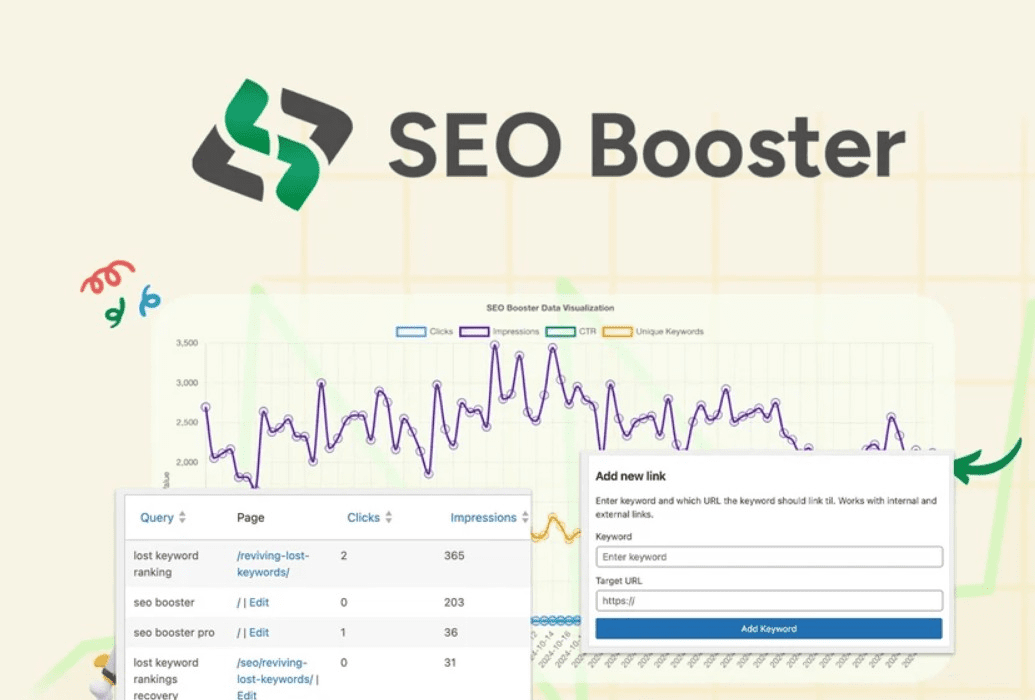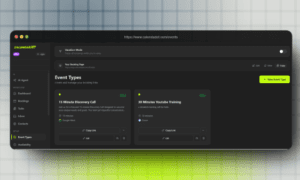SEO Booster is a WordPress plugin that integrates directly with your Google Search Console account. It pulls key performance data like clicks, impressions, CTR, and keyword rankings into your WordPress dashboard. Its primary functions are to make this data more accessible and actionable for content optimization.
The plugin also features a powerful engine for automating the creation of internal links across your entire site based on specified keywords. Additionally, it helps maintain site health by monitoring for and reporting on 404 errors, providing a focused toolkit to enhance on-page SEO and improve site architecture efficiently.
SEO Booster Pricing Plan:

SEO Booster 10 Key Features:
01: Direct (GSC) Integration
The cornerstone of the WordPress SEO plugin is its seamless integration with the Google Search Console API. This feature pulls live performance SEO data directly into your WordPress admin area, effectively eliminating the need to constantly switch between browser tabs.
The specific metrics made available include impressions, clicks, click-through rate (CTR), and average ranking position for your keywords and pages. This data is presented in clean, interactive tables that are far more intuitive to navigate than the standard GSC interface. Users can quickly search, sort, and filter the information by page, keyword, or performance metric, allowing for rapid analysis.
The immediate benefit is a significant improvement in workflow efficiency. By placing crucial performance data right next to the content editor, the plugin closes the gap between insight and action, allowing you to make data-informed optimization decisions without ever leaving your website’s backend.
02. Automatic Internal Linking Engine
This feature is arguably the plugin’s most powerful time-saver. It provides a robust system for automating the creation of internal links across your entire website.
The process is straightforward: a user defines a specific keyword or phrase and the destination URL they want it to link to. The plugin then scans every post, page, and even WooCommerce product description on the site, automatically converting each instance of that phrase into a hyperlink pointing to the designated page.
This process works retroactively on all existing content and applies to new content as it is published. This capability is a strategic tool for building a strong site architecture. It helps to systematically funnel link equity to your most important pillar pages or product pages, improves user navigation, and sends clear signals to search engines about which pages are authoritative for specific topics.
03. Comprehensive 404 Error Monitoring
Broken links are a silent killer for both user experience and SEO. They create frustrating dead ends for visitors and waste valuable crawl budgets from search engines. The plugin addresses this with a dedicated 404 error monitoring module. It actively logs every time a visitor or search engine bot attempts to access a URL on your site that does not exist.
These “404 Not Found” errors are compiled into a clean, actionable report directly within the WordPress dashboard. This allows site administrators to quickly identify problematic links perhaps from an old page that was deleted or a typo in an external link and resolve them.
By providing a clear and current list of all 404 errors, the tool empowers you to maintain a healthy site structure, improve user retention, and ensure your SEO efforts aren’t being undermined by technical issues.
04. On-Site Data Ownership & Control
In an era where data privacy is paramount, this feature is a significant differentiator. Unlike many cloud-based SEO tools that store your website’s performance data on their own servers, this plugin keeps all of your information on your own turf.
All the data imported from Google Search Console, along with the plugin’s configuration settings, is stored directly within your local WordPress database. This approach has two major implications. First, it ensures complete data sovereignty; you retain full ownership and control over your sensitive analytics, with no third-party tracking or external storage. Second, it prevents vendor lock-in.
If you decide to stop using a SaaS tool, you often lose access to your historical data. With this plugin, that data remains on your server, preserving your performance history and giving you the freedom to manage your tools without penalty.
05. Actionable Page-by-Page Keyword Insights
Beyond a site-wide overview, the plugin provides granular keyword performance data for each individual post and page. While using the WordPress editor, you can access a detailed breakdown of all the search queries that are driving impressions and clicks to that specific URL. This is an invaluable tool for executing a content refresh strategy.
For example, you can instantly see if a page is ranking for its primary target keyword or, more importantly, if it’s gaining traction for unexpected “striking distance” keywords that you haven’t fully optimized for.
This allows for highly targeted content updates. By identifying these latent ranking opportunities directly within the editing interface, you can quickly modify your content to better incorporate those terms, potentially converting passive impressions into high-value, top-ranking clicks and significantly boosting organic traffic.
06. Automated Weekly Email Reports
For busy site owners and agencies managing multiple clients, staying on top of SEO performance can be a challenge. The plugin simplifies this with an automated weekly email reporting feature. Each week, the system compiles a summary of your website’s key performance indicators and delivers it directly to your inbox.
These reports provide a high-level, digestible overview of important trends, such as changes in overall clicks and impressions, top-performing pages, and newly discovered keyword opportunities. The report also flags critical site health issues, such as any new 404 errors that have been detected over the past week.
This “set it and forget it” functionality ensures you remain informed of your site’s SEO pulse without needing to manually log in and check the dashboard, making it an efficient tool for long-term monitoring and quick identification of issues requiring attention.
07. WooCommerce & Page Builder Compatibility
The modern WordPress ecosystem is diverse, extending far beyond simple blog posts. Recognizing this, the plugin was built to be compatible with a wide range of popular tools, including WooCommerce and major page builders like Elementor, Divi, Beaver Builder, and Gutenberg. For e-commerce stores running on WooCommerce, the automatic internal linking feature is especially powerful.
A store owner can create rules to automatically link every mention of a product name or category across their blog content directly to the relevant shop page, creating a seamless path for users from content to conversion.
08. Keyword Data History & Tracking
A single snapshot of your SEO data is useful, but the real value lies in tracking performance over time. Because the plugin stores all imported GSC data on your local server, it builds a historical record of your keyword and page performance.
This allows you to measure the direct impact of your optimization efforts. For instance, after updating a blog post to target a new keyword, you can monitor its ranking position and click-through rate over the subsequent weeks and months to verify if your changes were successful.
This historical data is also crucial for identifying content decay and the natural decline in rankings that can happen to older posts. By spotting a downward trend in a once-popular article, you can prioritize it for a content refresh, update it with new information, and work to reclaim its previous high-ranking position.
09. Keyword Insights within the WordPress Editor
This feature represents the ultimate fusion of data and action. The plugin brings GSC performance metrics directly into the WordPress post and page editor, where content is actively being created and refined.
While writing or updating an article, a user can open a meta box or a popup window that displays a table of all the keywords that a specific URL is currently ranking for, along with their associated clicks, impressions, and CTR. This provides an immediate feedback loop for content creators. For example, a writer can see that a post is getting impressions for a long-tail keyword they hadn’t intentionally targeted.
They can then make real-time adjustments to the text, adding the keyword to a subheading or expanding a paragraph to address it more directly without ever having to leave the editor screen.
SEO Booster successfully achieves its core mission: it brilliantly integrates Google Search Console data directly into the WordPress workflow and provides powerful automation for internal linking. For this specific purpose, it is an elegant and highly efficient tool that can save hours of manual work for any serious content publisher or SEO agency.





























